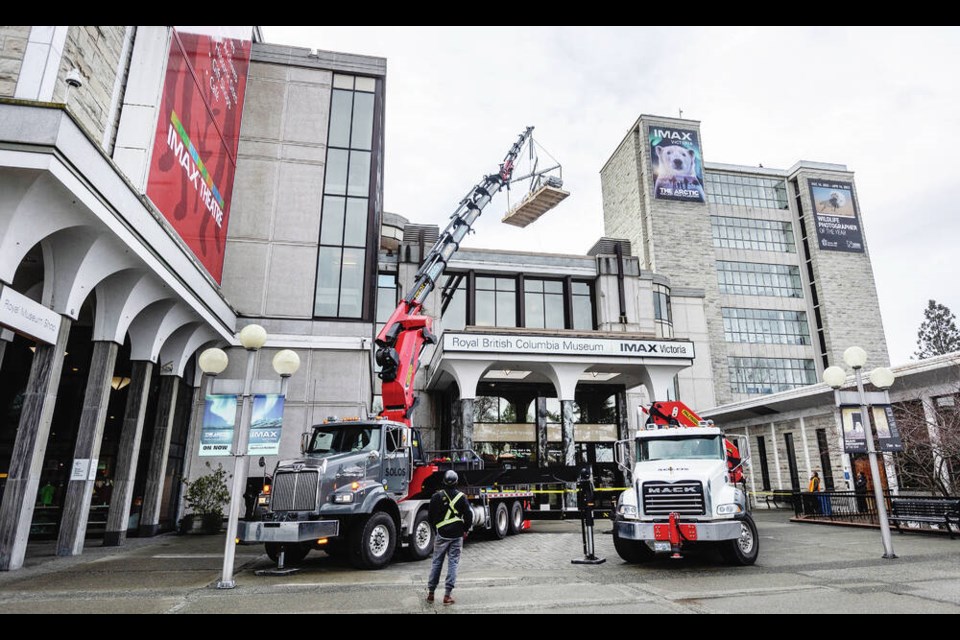Removing a totem pole from the third floor of the Royal B.C. Museum for repatriation to a First Nation involved taking down a temporary wall, cataloguing hundreds of exhibit items for storage, reinforcing the floor and removing a window.
The pole is “one of the tougher” items logistically that the museum has repatriated, said Janet Hanuse, the museum’s vice-president of engagement and Declaration on the Rights of Indigenous Peoples Act implementation.
The 800-kilogram totem pole was removed from the museum’s third floor by crane Monday morning to begin its journey to the homeland of the Nuxalk Nation near Bella Coola. The pole was initially a longhouse entrance pole, which is sacred to the Nuxalkmc people.
Months of work went into preparing the totem pole for repatriation, with about 20 to 30 staff and more external partners working on the project, Hanuse said.
Hundreds of exhibit pieces were taken off shelves to make way for the pole to come down, with careful record keeping to put them into storage, she said.
Other staff were simultaneously choreographing a route for the totem pole from its place on the third floor’s First Peoples Gallery to a window where it could exit the building, Hanuse said. Staff needed to weave it through the other 15 or so totem poles lining the gallery’s Totem Hall.
“So we had to move it carefully and move it through the poles so they’re not hitting anything, through the wall so that we could get it to the window,” she said.
Yet another team crafted a custom wrapping and casing to protect the pole during the trip out of the building and up north.
When the totem poles in the hall were first brought into the gallery, three holes were cut in the floor of each storey to hoist the poles up from the basement, she said.
Flooring on the third floor needed to be reinforced to hold the weight of an indoor crane used to bring the totem pole over to the window. From there, a crane outside lowered the pole to the ground.
“It felt like reconciliation just inside myself to be able to see that,” said Hanuse, adding she watched the pole’s removal as both an executive of the museum and an Indigenous person descending from the Gwa’sala, Nak’waxda’xw and ‘Wuikinukv Nations.
The pole was sitting on a truck Tuesday, Hanuse said, ready to begin the journey north to Bella Coola via Williams Lake, where Nuxalk members plan to form a convoy to complete the trip home with the pole.
The cost of returning the pole is covered by the museum, along with the travel costs for Hereditary Chief Snuxyaltwa, who requested the repatriation, Hanuse said. The final cost of the work is not yet known, but is in the tens of thousands of dollars, she said.
Conversations are ongoing with the elected government of the Nuxalk Nation to return another totem pole, as well as with three other nations to return items that include ceremonial masks, rattles, aprons, feast dishes and tools, totalling around 100 pieces, Hanuse said.
Previously, the museum limited communities to requesting 50 per cent of their belongings from the collection but that’s no longer the case, she said. “We’ve changed that and said we’ll repatriate whatever the communities request.”
Timelines for repatriating items are left to each nation to decide, she said, but the museum probably needs at least 12 weeks to prepare an item. The repatriation of the totem pole removed Monday was delayed partly because of requests from both the elected government of the Nuxalk Nation and Hereditary Chief Snuxyaltwa, which needed to be settled within the community before the museum could release the pole, Hanuse said.
Repatriating belongings to First Nations is a process of righting past wrongs and an essential precursor to “substantive reconciliation in society,” said Ry Moran, the University of Victoria’s associate university librarian for reconciliation.
“We are building a much better and healthier society as a whole. At one point in the future, all of the objects that were taken wrongfully in the first place will be rightfully returned back to the communities,” Moran said.
Meanwhile, on Monday, Tourism Minister Lana Popham floated the idea of reopening the museum’s Old Town exhibit, which has been closed since late 2021. Hanuse said the museum is asking British Columbians for their input to reimagine the exhibit and doesn’t intend to keep it closed forever.
They’re hoping to address concerns about a separation between the Old Town exhibit and the First Peoples Gallery that presented the story of B.C. as a divided society, she said.
“We just want to revisit it and say: ‘Is this what B.C. really was, and if not, what was it? How do we tell that story in a way that everybody feels proud of and feels a part of?” Hanuse said.
>>> To comment on this article, write a letter to the editor: [email protected]



